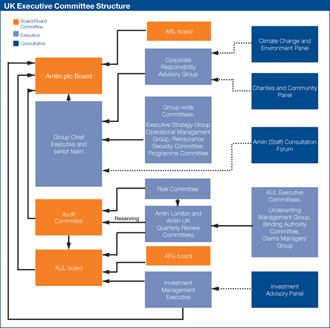Accountability
Corporate Governance
Changes in executive corporate governance structure
Board level corporate governance is only the most visible aspect of a review, decision-making and consultative structure that goes much deeper, as illustrated in the chart below. The executive team has many internal processes to operate and decisions to make, all of which require clearly defined authorities and processes.

Click here for full sized image
In 2008 the centre of the executive function for all aspects of the UK-based businesses, and for most Group executive matters, was the Executive Management Group, consisting of nine senior executives led by the Group Chief Executive. During the year this structure was reviewed and changes have been made with effect from 1 January 2009. Instead of managing the Group in two parts, Lloyd’s and Bermuda, going forward the business is being managed in four parts: Amlin London (the old Non-marine, Marine and Aviation divisions), Amlin UK (the UK commercial insurance business), Amlin Bermuda and AFU. The operating subsidiary for the first two, both still being Lloyd’s businesses conducted through Syndicate 2001, remains AUL but its executive governance has been split between an Amlin London management committee and an Amlin UK management committee. Each of these contains the appropriate executive management and will hold quarterly review meetings with Group executives, including the Group Chief Executive, Group Finance Director and Chief Risk Officer, at which the latter will operate effectively as internal non-executives. By making this clearer distinction between subsidiary and Group management, it is intended to facilitate the addition of further business platforms beyond the existing ones as opportunities arise, whilst focusing Group level executives on the overall management of the Group’s development.
Some committees of executives report directly into the Board level governance structure, such as the Risk Committee (which reports to the Audit Committee), and others report to the Amlin London and/or the Amlin UK management committees. The old Executive Management Group has been disbanded but the Executive Strategy Group, which has a similar membership and assists the Group Chief Executive on strategic issues, remains.
The business functions themselves are all described in more detail in the Review section of the Annual Report. Summaries of the changing governance arrangements of a few of these now follow:
Reserving
The ultimate responsibility for the Group’s reserving is that of the boards but it is also important that the process whereby executive management reaches reserving recommendations is objective and robust. The role of the AUL Reserving Committee, which operated up to third quarter reserving in 2008, was to review, and finalise, the preliminary reserving conclusions for the whole of Syndicate 2001 each quarter, reporting to the AUL board. This role will now be performed by the new Amlin London and Amlin UK quarterly review meetings, which will each report to AUL quarterly board meetings and, twice-yearly, to the Audit Committee. The Reserving Committee during the year, and the two quarterly review meetings going forward, receive internal actuarial reports from the Group Risk Assessment & Monitoring department reviewing the consistency of the key reserving judgements. In the cases of ABL (and, in the future, AFU), its board effectively acts as the reserving committee, receiving reports directly from its local management, which has the benefit of advice and analysis provided by the Group Risk Assessment & Monitoring department.
Risk management
There is a clear line of responsibility for risk management from business managers to the executive Risk Committee and, from there, to the Audit Committee reporting to both the AUL and plc boards. The Risk Committee also reports to the management of each business in the Group in order to ensure that recommendations for risk assessment, control and mitigation are carefully considered and acted upon at executive level. Further details of the Group’s risk management, and its development during the year, are set out in the Review section of the Annual Report. The conclusions of the Board’s review of internal control is set out in the ‘Board internal control statement’ later in this report.
Investments
The setting and execution of the Group’s investment strategy has its own hierarchy of responsibilities. These have not changed as a result of the other governance changes made at the end of the year. The relevant boards (AUL for syndicate funds, which includes its underwriting and capital assets, ABL for its own funds, and Amlin plc for surplus capital and a Group overview) are responsible for their own overall strategies. An Investment Management Executive consisting of the Group Finance Director, Group Chief Executive and Chief Investment Officer has responsibility for important tactical decisions with operational decisions being taken by the Chief Investment Officer. The executive is assisted in its decision making and recommendations to the boards by an Investment Advisory Panel (IAP) consisting of the Investment Management Executive plus three external investment experts. ABL decisions are made locally but with advice from Group investments. The whole process is governed by a comprehensive investment governance manual, which defines what decisions may be taken at what level.
Corporate responsibility
The Group Chief Executive has Board level responsibility for all corporate responsibility matters. During 2008, governance arrangements were changed and based on a Charities and Community Panel and a Climate Change and Environment Panel. Both report to a new Corporate Responsibility Advisory Group, which is responsible for reviewing the adequacy of the Group’s overall corporate responsibility activities. The fruits of this structure are reflected in the separate Corporate Responsibility report that follows the corporate governance reports.
